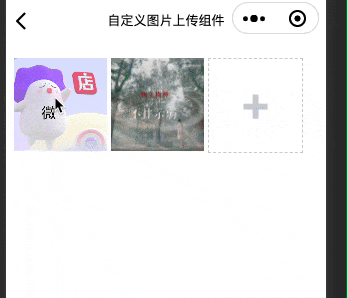жӮЁеҘҪпјҢзҷ»еҪ•еҗҺжүҚиғҪдёӢи®ўеҚ•е“ҰпјҒ
иҝҷзҜҮж–Үз« дё»иҰҒд»Ӣз»ҚвҖңеҫ®дҝЎе°ҸзЁӢеәҸжҖҺд№Ҳе®һзҺ°еӣҫзүҮжӢ–жӢҪжҺ’еәҸвҖқзҡ„зӣёе…ізҹҘиҜҶпјҢе°Ҹзј–йҖҡиҝҮе®һйҷ…жЎҲдҫӢеҗ‘еӨ§е®¶еұ•зӨәж“ҚдҪңиҝҮзЁӢпјҢж“ҚдҪңж–№жі•з®ҖеҚ•еҝ«жҚ·пјҢе®һз”ЁжҖ§ејәпјҢеёҢжңӣиҝҷзҜҮвҖңеҫ®дҝЎе°ҸзЁӢеәҸжҖҺд№Ҳе®һзҺ°еӣҫзүҮжӢ–жӢҪжҺ’еәҸвҖқж–Үз« иғҪеё®еҠ©еӨ§е®¶и§ЈеҶій—®йўҳгҖӮ

еҜ№дәҺ组件еҶ…йғЁжқҘиҜҙгҖӮ笔иҖ…жҸҗдҫӣдәҶдёҖдёӘеҸӮж•°еҺ»и®©ејҖеҸ‘иҖ…еҶіе®ҡжҳҜеҗҰеә”иҜҘеңЁеңәжҷҜдёӯж”ҜжҢҒжӢ–еҠЁжҺ’еәҸгҖӮиҝҷйҮҢз•ҘеҺ»иҝҷдәӣж— е…ід»Јз ҒгҖӮ
жӢ–жӢҪжҺ’еәҸеҠҹиғҪдҪҝз”ЁдәҶеҫ®дҝЎе°ҸзЁӢеәҸжҸҗдҫӣзҡ„movable-area组件пјҲж ҮзӯҫпјҢдҪҶе°ҸзЁӢеәҸд№ҹжҳҜе°ҒиЈ…дәҶHTMLпјҢжүҖд»Ҙд»ҘеҺҹз”ҹ组件代称пјүгҖӮе®ғзӣёеҪ“дәҺжҸҗдҫӣдәҶдёҖдёӘеҸҜж»‘еҠЁеҢәеҹҹпјҢеңЁжӯӨеҢәеҹҹеҶ…зҡ„movable-view组件еҶ…е®№еҸҜд»Ҙд»»ж„ҸжҺ’еҲ—гҖӮе…¶ж•Ҳжһңе°ұзӣёеҪ“дәҺwindowдёӯзҡ„вҖңжЎҢйқўеӣҫж ҮйқһеҜ№йҪҗвҖқж•Ҳжһң —— и®°дҪҸиҝҷдёӘжҸҸиҝ°пјҢе®ғе’ҢдёӢйқўзҡ„еҶ…е®№иҒ”зі»зҙ§еҜҶпјҒ
е…¶дёӯдё»иҰҒзҡ„дёӨдёӘеҸӮж•°жҳҜпјҡ
xпјҡе®ҡд№үxиҪҙж–№еҗ‘зҡ„еҒҸ移пјҢеҰӮжһңxзҡ„еҖјдёҚеңЁеҸҜ移еҠЁиҢғеӣҙеҶ…пјҢдјҡиҮӘеҠЁз§»еҠЁеҲ°еҸҜ移еҠЁиҢғеӣҙпјӣж”№еҸҳxзҡ„еҖјдјҡи§ҰеҸ‘еҠЁз”»пјӣ
yпјҡе®ҡд№үyиҪҙж–№еҗ‘зҡ„еҒҸ移пјҢеҰӮжһңyзҡ„еҖјдёҚеңЁеҸҜ移еҠЁиҢғеӣҙеҶ…пјҢдјҡиҮӘеҠЁз§»еҠЁеҲ°еҸҜ移еҠЁиҢғеӣҙпјӣж”№еҸҳyзҡ„еҖјдјҡи§ҰеҸ‘еҠЁз”»пјӣ
е—ҜпјҢеҸҜд»ҘзҹҘйҒ“пјҢе…¶еҶ…йғЁжҳҜйҖҡиҝҮ js и§ҰеҸ‘зҡ„еҠЁз”»гҖӮиҖҢдё”еҸҜиғҪжҳҜrequestAnimeFrame APIгҖӮ
зҹҘйҒ“дәҶжүҖз”Ёж ҮзӯҫпјҢжҺҘдёӢжқҘе°ұиҜҘжӯЈејҸејҖеҸ‘дәҶгҖӮдҪҶжҳҜдҪ дјҡеҸ‘зҺ°пјҢиҝҷйҮҢе…¶е®һжңүдёӨз§ҚдҪҝз”Ёж–№ејҸпјҡ
еҜ№жҜҸдёӘе…ғзҙ дҪҝз”Ёmovable-viewеҢ…иЈ№пјҢ让他们еҸҜд»ҘйҡҸж„ҸжӢ–жӢҪдҪҚзҪ®пјҡ
<view class="container">
<movable-area >
<view class="image-list">
<!-- жҳҫзӨәеӣҫзүҮ -->
<block wx:if="{{yMovable}}">
<movable-view x="{{x}}" y="{{y}}" direction="all" inertia damping="{{5000}}" friction="{{1}}" disabled="{{disabled}}" wx:for="{{images}}" wx:key="{{item.index}}">
<view class="image-wrap image-bg {{(images.length > 2) ? 'image-flex' : ''}}" id="{{item.index}}" data-index='{{index}}' bindlongpress='onShowMenu' bindtouchstart='touchs' bindtouchend='touchend' bindtouchmove='touchm'>
<image class="image" src="{{item.img}}" mode="aspectFill" bind:tap="onPreviewImage" data-imgsrc="{{item.img}}"></image>
<i class="iconfont icon-delete" wx:if="{{showMenuImg}}" bind:tap="onDelImage" data-index="{{index}}"></i>
</view>
</movable-view>
</block>
<!-- йҖүжӢ©еӣҫзүҮ -->
<view class="image-wrap selectphoto" bind:tap="onChooseImage" hidden="{{!selectPhoto}}">
<i class="iconfont icon-jiashang"></i>
</view>
</view>
</movable-area>
</view>еӣҫзүҮеҸӘжҳҜеұ•зӨәпјӣеҚ•зӢ¬и®ҫзҪ®дёҖдёӘе…ғзҙ пјҢеңЁй•ҝжҢүеӣҫзүҮж—¶жҳҫзӨәпјҢе…¶еҖјдёәеҪ“еүҚйҖүдёӯзҡ„еӣҫзүҮпјҢжӢ–жӢҪзҡ„жҳҜиҝҷдёӘе…ғзҙ пјҢеҲ°иҫҫзӣ®ж ҮдҪҚзҪ®еҗҺж¶ҲеӨұпјҢеӣҫзүҮеҲ—иЎЁйҮҚж–°жҺ’еәҸгҖӮ
<view class="container">
<movable-area >
<view class="image-list">
<!-- жҳҫзӨәеӣҫзүҮ -->
<block wx:if="{{yMovable}}">
<block wx:for="{{images}}" wx:key="{{item.index}}">
<view class="image-wrap image-bg {{(images.length > 2) ? 'image-flex' : ''}}" id="{{item.index}}" data-index='{{index}}' bindlongpress='onShowMenu' bindtouchstart='touchs' bindtouchend='touchend' bindtouchmove='touchm'>
<image class="image" src="{{item.img}}" mode="aspectFill" bind:tap="onPreviewImage" data-imgsrc="{{item.img}}"></image>
<i class="iconfont icon-delete" wx:if="{{showMenuImg}}" bind:tap="onDelImage" data-index="{{index}}"></i>
</view>
</block>
<movable-view x="{{x}}" y="{{y}}" direction="all" inertia damping="{{5000}}" friction="{{1}}" disabled="{{disabled}}">
<view class='image-wrap image-check' hidden='{{hidden}}'>
<image class="image" src="{{doubleImg}}" mode="aspectFill"></image>
</view>
</movable-view>
</block>
<!-- йҖүжӢ©еӣҫзүҮ -->
<view class="image-wrap selectphoto" bind:tap="onChooseImage" hidden="{{!selectPhoto}}">
<i class="iconfont icon-jiashang"></i>
</view>
</view>
</movable-area>
</view>第дёҖз§Қж–№ејҸзҡ„дјҳеҠҝеңЁдәҺпјҡеҸҜд»ҘжңүжӣҙеҠ вҖңзңҹе®һвҖқзҡ„ж•ҲжһңгҖӮиҝҷйҮҢзҡ„зңҹе®һж„ҸдёәйҮҚж–°жҺ’еҲ—ж—¶д№ҹжңүж»‘еҠЁзҡ„еҠЁз”»ж•ҲжһңгҖӮдҪҶжҳҜеёҰжқҘзҡ„жҖ§иғҪжҚҹиҖ—д№ҹжҳҜжһҒеӨ§зҡ„пјҢдҪ еҸӘиғҪе°ҪеҠӣи°ғжҺ§еҗ„з§Қж•°жҚ®жқҘи®©жҳҫзӨәжӣҙеҠ вҖңи·ҹжүӢвҖқдёҖдәӣгҖӮдҪҶжҳҜеҹәдәҺжӯӨпјҢдҪ еҸҜд»ҘйҖҡиҝҮjsи®Ўз®—иҫҫеҲ°еғҸQQз©әй—ҙйӮЈж ·зҡ„е®һж—¶жҺ’еҲ—ж•ҲжһңпјҒ
第дәҢз§Қж–№ејҸзҡ„дјҳеҠҝеңЁдәҺпјҡжҖ§иғҪејҖй”ҖзӣёеҜ№е°ҸдёҖдәӣгҖӮдҪҶеұ•зӨәж•ҲжһңжӣҙеғҸwebиҖҢйқһAPPпјҲиҝҷдёӨдёӘзҡ„еҢәеҲ«дҪ еә”иҜҘжҳҜзҹҘйҒ“зҡ„пјүгҖӮ
еҪ“еүҚзүҲжң¬дёӯпјҢ笔иҖ…йҮҮз”Ёзҡ„жҳҜ第дәҢз§Қж–№ејҸгҖӮе…¶е…ій”® js д»Јз ҒеҰӮдёӢпјҡ
const MAX_IMG_NUM=9;
Component({
/**
* 组件зҡ„еұһжҖ§еҲ—иЎЁ
*/
properties: {
yMovable:{
type:Boolean,
value:false
},
},
/**
* 组件зҡ„еҲқе§Ӣж•°жҚ®
*/
data: {
images:[],
selectPhoto:true,
showMenuImg: false,
flag: false,
hidden:true,
x:0,
y:0,
disabled: true,
elements:[],
doubleImg: ""
},
/**
* 组件зҡ„ж–№жі•еҲ—иЎЁ
*/
methods: {
//й•ҝжҢүдәӢ件
onShowMenu(e){
const detail = e.currentTarget;
if(!this.data.showMenuImg) {
// дҪҝжүӢжңәжҢҜеҠЁ15ms
wx.vibrateShort();
}
this.setData({
showMenuImg: true
})
if(this.properties.yMovable) {
this.setData({
x: detail.offsetLeft+5,
y: detail.offsetTop,
hidden: false,
flag:true,
doubleImg: this.data.images[detail.dataset.index].img
})
}
},
//и§Ұж‘ёејҖе§Ӣ
touchs:function(e){
this.setData({
beginIndex:e.currentTarget.dataset.index
})
},
//и§Ұж‘ёз»“жқҹ
touchend:function(e){
if (!this.data.flag) {
return;
}
const x = e.changedTouches[0].pageX
const y = e.changedTouches[0].pageY
const list = this.data.elements;
let data = this.data.images
for(var j = 0; j<list.length; j++){
const item = list[j];
if(x>item.left && x<item.right && y>item.top && y<item.bottom){
const endIndex = item.dataset.index;
const beginIndex = this.data.beginIndex;
//еҗ‘еҗҺ移еҠЁ
if (beginIndex < endIndex) {
let tem = data[beginIndex];
for (let i = beginIndex; i < endIndex; i++) {
data[i] = data[i + 1]
}
data[endIndex] = tem;
}
//еҗ‘еүҚ移еҠЁ
if (beginIndex > endIndex) {
let tem = data[beginIndex];
for (let i = beginIndex; i > endIndex; i--) {
data[i] = data[i - 1]
}
data[endIndex] = tem;
}
this.setData({
images: data
})
this.initImg(this.triggerMsg(data, "sort-img"))
}
}
this.setData({
hidden: true,
flag: false
})
},
//ж»‘еҠЁ
touchm:function(e){
if(this.data.flag){
const x = e.touches[0].pageX
const y = e.touches[0].pageY
this.setData({
x: x - 75,
y: y - 45
})
}
},
//йҖүжӢ©еӣҫзүҮ
onChooseImage(){
let images = this.data.images;
let imageLen = images.length;
let max=MAX_IMG_NUM-imageLen;
wx.chooseImage({
count:max,
sizeType:['original','compressed'],
sourceType:['album','camera'],
success: (res) => {
max-=res.tempFilePaths.length;
let _images = images.map(item => {
return item.img
})
images = _images.concat(res.tempFilePaths)
for(let i=0;i<images.length;i++) {
images[i] = {
img: images[i],
index: i+1
}
}
this.setData({
selectPhoto:max<=0?false:true,
images,
showMenuImg: false
})
this.triggerMsg(images, "choose-img")
if(this.properties.yMovable) {
this.initImg()
}
},
fail:(res)=>{
}
})
},
// еҲқе§ӢеҢ–дҪҚзҪ®дҝЎжҒҜ
initImg(fn=function(){}) {
let query = wx.createSelectorQuery().in(this);
let nodesRef = query.selectAll(".image-bg");
nodesRef.fields({
dataset: true,
rect:true
},(result)=>{
this.setData({
elements: result;
fn();
})
}).exec()
},
//еҲ йҷӨ
onDelImage(event){
let images = this.data.images;
images.splice(event.target.dataset.index,1)
this.setData({
images
})
this.initImg(this.triggerMsg(images, "delete-img"))
if(images.length== MAX_IMG_NUM-1){
this.setData({
selectPhoto:true
})
}
},
triggerMsg(images, key) {
this.triggerEvent('chooseImg', {
images: images.map(item => {
return item.img
}),
key: key
})
},
}
})дёҠйқўд»Јз ҒдёӯжңҖйҮҚиҰҒзҡ„е°ұжҳҜinitImgеҮҪж•°зҡ„иҝҷж®өд»Јз ҒпјҒе®ғз”ЁжқҘиҺ·еҸ–wxmlиҠӮзӮ№зҡ„зӣёе…іеұһжҖ§пјҒfields APIзҡ„еҸӮж•°еҸҠй»ҳи®ӨеҖјжңүпјҡ
id:false,//жҳҜеҗҰиҝ”еӣһиҠӮзӮ№id rect:fasle,//жҳҜеҗҰиҝ”еӣһиҠӮзӮ№еёғеұҖдҪҚзҪ® dataset: true,//иҝ”еӣһж•°жҚ®йӣҶ size: true,//иҝ”еӣһе®Ҫй«ҳ scrollOffset: true,//иҝ”еӣһ scrollLeft,scrollTop properties: ['scrollX', 'scrollY'],//зӣ‘еҗ¬еұһжҖ§еҗҚ computedStyle: ['margin', 'backgroundColor']//жӯӨеӨ„иҝ”еӣһжҢҮе®ҡиҰҒиҝ”еӣһзҡ„ж ·ејҸеҗҚ
иҝҷдёӘAPIзҡ„и°ғз”ЁжҳҜеҗҺйқўе®ҡдҪҚзҡ„е…ій”®пјҢе®ғеҝ…йЎ»ж”ҫеңЁиҺ·еҸ–еҲ°еӣҫзүҮж•°з»„д№ӢеҗҺжү§иЎҢпјҲдёҚз®ЎеҗҢжӯҘиҝҳжҳҜејӮжӯҘзҡ„пјүгҖӮд№ҹжҳҜ第дәҢз§Қж–№жі•е’Ң第дёҖз§Қж–№жі•зҡ„еҢәеҲ«д№ӢеӨ„ —— 第дёҖз§Қж–№жі•жҳҜзәҜ js и®Ўз®—е®һж—¶дҪҚзҪ®гҖӮжүҖд»Ҙе®ғйңҖиҰҒеңЁз»“жқҹеҗҺиҝӣиЎҢжҺ’еәҸгҖӮ
иҝҷж—¶еҖҷй—®йўҳе°ұжқҘдәҶпјҡеғҸжң¬ж–Үиҝҷз§ҚеңәжҷҜпјҢеҗҢж—¶жңү x е’Ң y дёӨдёӘж–№еҗ‘зҡ„дҪҚзҪ®пјҢsortе°ҶдјҡжһҒе…¶еӨҚжқӮпјҢиҖҢдё”sortжң¬иә«зҡ„жҖ§иғҪе°Ҷдјҡиў«еҶ…йғЁз№ҒжқӮзҡ„д»Јз Ғжӯ»жӯ»жӢ–дҪҸгҖӮиҝҷе°ұжҳҜдёҠйқўиҜҙ第дёҖз§Қж–№жі•жҖ§иғҪй—®йўҳзҡ„еҺҹеӣ жүҖеңЁгҖӮ
дҪҶжҳҜжң¬ж–Үиҝҷз§Қж–№жі•е°Ҷsortз®ҖеҢ–дёәеҪ“еүҚжӢ–еҠЁе…ғзҙ е’Ңзӣ®ж ҮдҪҚзҪ®еӣҫзүҮдёӨдёӘзү©дҪ“зҡ„еӣӣдёӘж–№еҗ‘еҲӨж–ӯпјҢд№ҹе°ұжҳҜз»Ҹе…ёвҖңе°Ҹзҗғж’һеўҷвҖқдёҙз•Ңй—®йўҳгҖӮиҝҷд№ҹжҳҜе…¶дјҳеҠҝжүҖеңЁгҖӮ
еҸҰдёҖдёӘйңҖиҰҒжіЁж„Ҹзҡ„ең°ж–№е°ұжҳҜ touchmеҮҪж•°дёӯзҡ„setDataгҖӮиҝҷйҮҢйқўиҝӣиЎҢзҡ„жҳҜжӢ–жӢҪе…ғзҙ дҪҚзҪ®ж”№еҸҳпјҢд№ҹе°ұжҳҜвҖңи·ҹжүӢзҺҮвҖқпјҲжҲ‘иҮӘе·ұзј–зҡ„пјүгҖӮеҸҜд»ҘеҜ№жӯӨж•°еҖјиҝӣиЎҢеҫ®и°ғжқҘи®©ж•ҲжһңжӣҙеҠ niceдёҖдәӣгҖӮ
йҰ–е…ҲеңЁjsonж–Ү件дёӯиҝӣиЎҢ组件引е…Ҙпјҡ
{
"usingComponents": {
"y-img":"/components/yImg/index"
}
}然еҗҺеҶҚwxmlдёӯпјҡ
<view class="container"> <y-img bind:chooseImg="chooseImg"></y-img> <!--жҲ–пјҡ--> <y-img yMovable bind:chooseImg="chooseImg"></y-img> </view>
chooseImg(e) {
console.log(e.detail)
},е…ідәҺвҖңеҫ®дҝЎе°ҸзЁӢеәҸжҖҺд№Ҳе®һзҺ°еӣҫзүҮжӢ–жӢҪжҺ’еәҸвҖқзҡ„еҶ…е®№е°ұд»Ӣз»ҚеҲ°иҝҷйҮҢдәҶпјҢж„ҹи°ўеӨ§е®¶зҡ„йҳ…иҜ»гҖӮеҰӮжһңжғідәҶи§ЈжӣҙеӨҡиЎҢдёҡзӣёе…ізҡ„зҹҘиҜҶпјҢеҸҜд»Ҙе…іжіЁдәҝйҖҹдә‘иЎҢдёҡиө„и®Ҝйў‘йҒ“пјҢе°Ҹзј–жҜҸеӨ©йғҪдјҡдёәеӨ§е®¶жӣҙж–°дёҚеҗҢзҡ„зҹҘиҜҶзӮ№гҖӮ
е…ҚиҙЈеЈ°жҳҺпјҡжң¬з«ҷеҸ‘еёғзҡ„еҶ…е®№пјҲеӣҫзүҮгҖҒи§Ҷйў‘е’Ңж–Үеӯ—пјүд»ҘеҺҹеҲӣгҖҒиҪ¬иҪҪе’ҢеҲҶдә«дёәдё»пјҢж–Үз« и§ӮзӮ№дёҚд»ЈиЎЁжң¬зҪ‘з«ҷз«ӢеңәпјҢеҰӮжһңж¶үеҸҠдҫөжқғиҜ·иҒ”зі»з«ҷй•ҝйӮ®з®ұпјҡis@yisu.comиҝӣиЎҢдёҫжҠҘпјҢ并жҸҗдҫӣзӣёе…іиҜҒжҚ®пјҢдёҖз»ҸжҹҘе®һпјҢе°Ҷз«ӢеҲ»еҲ йҷӨж¶үе«ҢдҫөжқғеҶ…е®№гҖӮ
жӮЁеҘҪпјҢзҷ»еҪ•еҗҺжүҚиғҪдёӢи®ўеҚ•е“ҰпјҒ